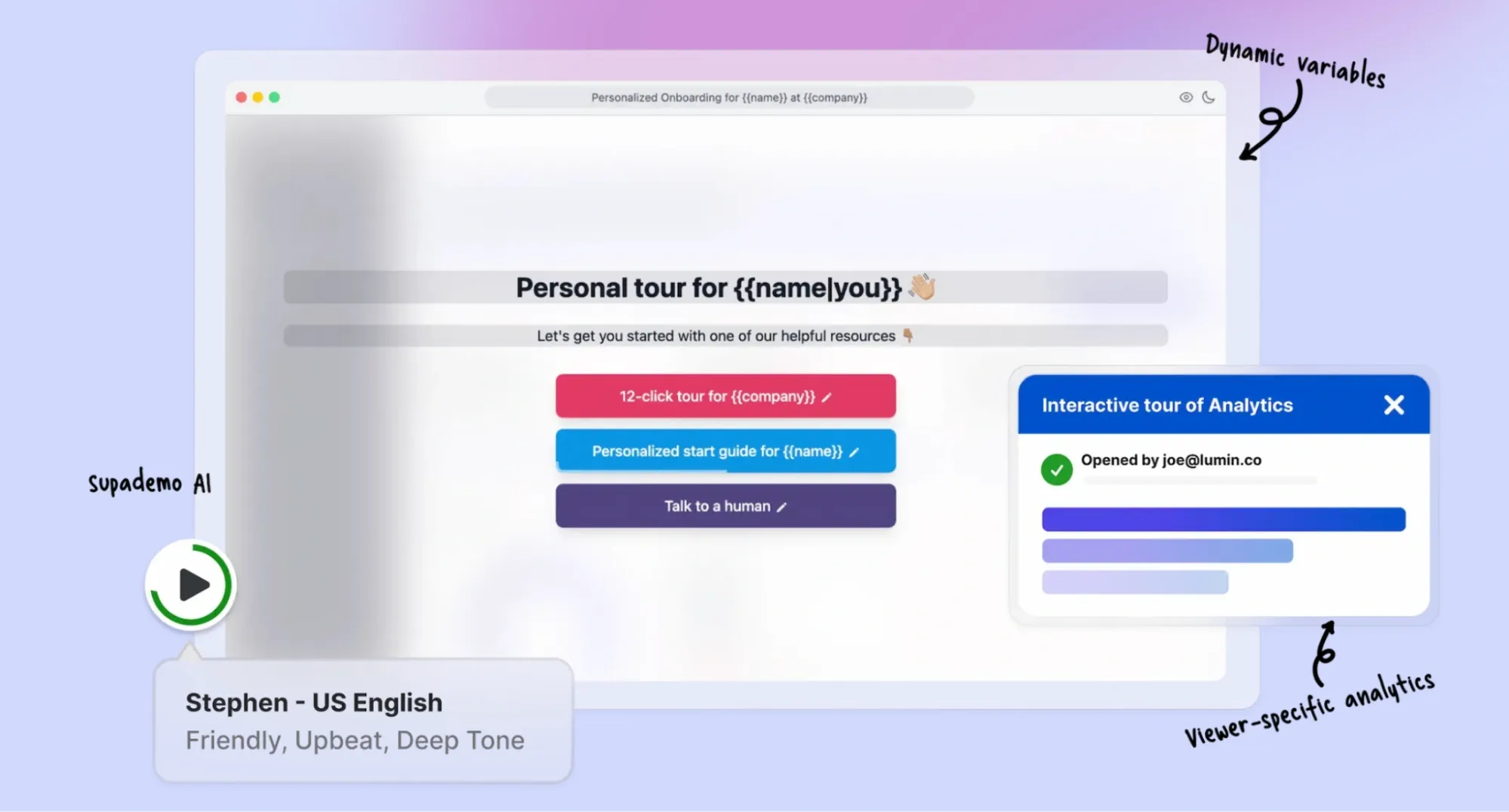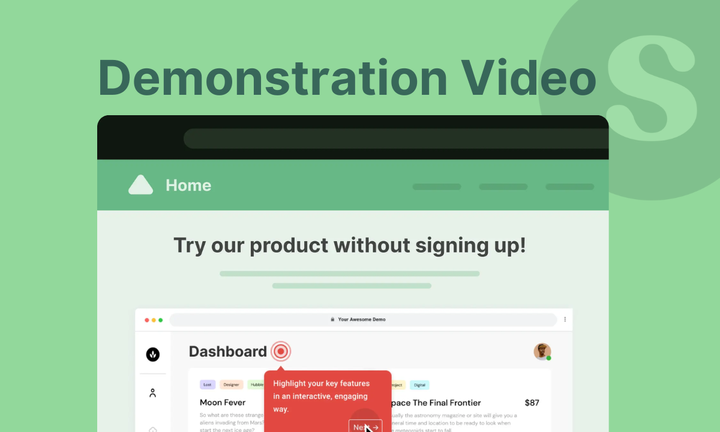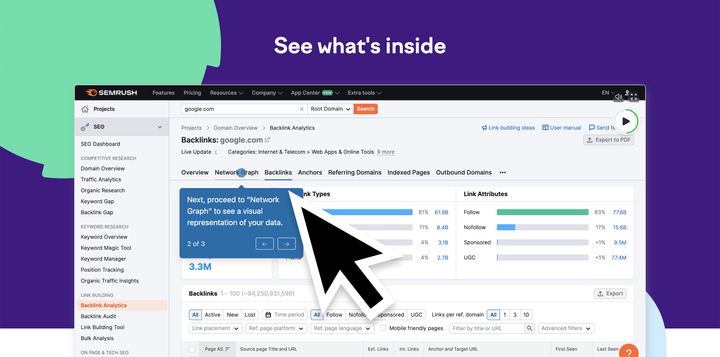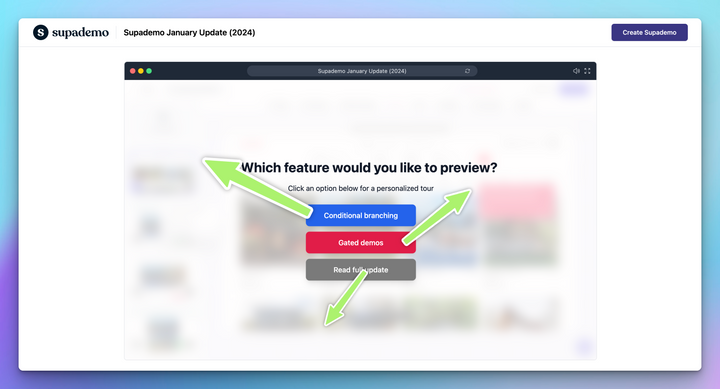Your product solves real problems. But getting prospects to understand that value quickly and clearly is harder than it sounds.
Demonstration videos let you show exactly how your product works, what problems it solves, and why someone should care, all in a format that's easy to share, reuse, and personalize. In fact, data shows that 89% of businesses now rely on video as part of their marketing strategy.
In this guide, we’ll break down in detail what demonstration videos are, their different types, and how to create demos that actually convert. So, let’s get into it.
TL;DR
2. Product demos reduce sales cycles, improve onboarding completion rates, and help teams scale their communication without endless meetings.
3. Choose from screencasts, animated demos, live-action videos, or interactive HTML demos based on your product and audience needs.
4. Successful demos follow a clear flow with planning your story, recording strategically, editing for clarity, and adding voiceover or annotations.
5. Tools like Supademo let you create click-through product demos in minutes, not days, with AI-powered enhancements.
What is a demonstration video? (And why use them?)
A demonstration video is a visual walkthrough that shows how a product or service works. Instead of just telling people what your product does, you show them the actual experience with clicks, workflows, features, and outcomes.
These videos can take multiple forms, such as screen recordings, animated walkthroughs, live-action footage, and interactive demonstration videos. The format changes based on what you're demonstrating, but the main purpose remains consistent across all types.
Recent data shows that 81% of companies now set aside specific budgets for video content, with many dedicating nearly half their marketing spend to it. This shift indicates how critical visual demonstrations have become for communicating product value across sales, marketing, and customer success.
Here's how various teams use demonstration videos throughout the customer journey:
- Sales teams: Share personalized demos showing prospects exactly how the product solves their specific problems, reducing time to close and qualifying leads faster.
- Marketing teams: Place demos on landing pages and in campaigns to convert visitors into leads by showing value before asking for sign-up or commitment.
- Customer success teams: Embed interactive product demos in knowledge bases to answer common questions without live support, reducing ticket volume and improving satisfaction.
- Product teams: Create demos for feature launches and product updates to drive adoption and gather early feedback from users.
- Customer support teams: Include demos in help articles and chat responses to provide visual answers that resolve issues faster than text explanations.
- Training teams: Build onboarding sequences with demos that let new users learn by doing rather than reading documentation or watching passive videos.
Understanding the purpose and benefits of demo videos
Demonstration videos solve a fundamental communication challenge. People want to see products in action before they commit. Reading feature lists doesn't create the same understanding as watching someone actually use the product.
The impact shows up across multiple business metrics. Here's what demonstration videos deliver:
- Faster comprehension: Viewers grasp complex workflows in seconds through visual learning instead of reading lengthy documentation.
- Better retention: People remember what they see and experience rather than what they read in text descriptions.
- Self-paced learning: Viewers can pause, rewind, and review without scheduling meetings or waiting for support responses.
- Scalable communication: Create once, then share everywhere from sales emails to support docs to onboarding sequences.
- Higher engagement: Interactive demos keep viewers actively involved rather than passively watching, leading to better conversion rates.
- Reduced friction: Prospects explore your product without signup walls, complex setup processes, or sales pressure.
Teams using demonstration videos consistently see shorter sales cycles, higher demo-to-trial conversion rates, and higher onboarding completion rates than with text-only content. The format reduces friction at every customer journey stage.
Demonstration videos vs explainer videos: What's the difference?
Demonstration videos and explainer videos both use the visual formats. But they serve distinct purposes and work at different funnel stages.
Explainer videos focus on the problem your product solves. They're usually animated, tell a story, and work well for building awareness. For example, an explainer can show how remote teams struggle with async communication, then introduce your tool as the solution. The content stays high-level and conceptual.
Demonstration videos focus on how the product actually works. They show specific features, real screens, and actual workflows. You're proving your solution delivers results by walking through it step by step. The content gets tactical and detailed.
Types of demonstration videos
Each demonstration format serves specific products, audiences, and use cases. Choosing the right type determines how quickly you can create demos and how effectively they convert viewers.
Knowing the different formats helps you choose what works best for your specific needs. Let’s take a detailed look at each one of them.
Screencast demo videos
Screencasts capture your actual product interface as you click through workflows. You record your screen, add voiceover or text annotations, and show exactly what users will experience when they use your product.
This format works well for software products, SaaS platforms, and digital tools where showing the real interface builds trust. For instance, demonstrating project management software through screencasts lets viewers see the actual dashboard layout, task creation process, and how team collaboration works in practice.
The main advantage is authenticity. Viewers see your real product, which sets accurate expectations and builds credibility. The main challenge is maintenance. When your UI changes, you need to re-record affected sections. Careful planning also matters because showing too many features too quickly creates confusion rather than clarity.
Animated demo videos
Animated demos use graphics, motion design, and illustrations to represent your product and workflows. Instead of recording actual screens, you create visual representations through animation.
This format excels at simplifying complex technical concepts, showing processes spanning multiple systems, and creating evergreen content that survives UI updates. For example, explaining how data flows between your application, third-party services, and customer systems is often clearer in an animation than in a screen recording.
Animation provides creative flexibility. You can visualize abstract concepts, highlight specific elements, and maintain visual consistency across multiple demos. The tradeoff is production time and cost. Quality animation requires specialized skills and takes longer to create. Making changes after production can be expensive, so getting the script and flow right up front matters more.
Live-action demo videos
Live-action demos film real people using physical products or interacting with software in actual environments. You demonstrate hands-on devices, facial reactions to results, and tangible outcomes in real settings.
These work best for physical products, hardware, or when the human element adds credibility to your story. For instance, showing a team collaborating in their office using your collaboration software creates an authentic connection that resonates with viewers.
Production requires more resources, including lighting equipment, cameras, shooting locations, and either actors or team members comfortable on camera. Plus, updates require arranging new shoots, so use this format when your product and primary use cases remain stable over time.
Interactive demo videos
Interactive demo videos let viewers explore your product hands-on through guided walkthroughs or open exploration. Unlike screencasts, these demos are clickable, self-paced, and easy to update. You can use them to create software demos, mobile app demos, interactive help docs, or feature tutorials.
Modern tools like Supademo let you capture a high-fidelity replica of your product using a Chrome extension or desktop app. Once recorded, you can customize flows, add AI voiceovers and translation, and share demos across the website, Slack, Notion, and more.
Interactive demos typically are of three types:
1. HTML demos
HTML demos recreate your product experience through guided, clickable flows that viewers can explore at their own pace. Each screen is fully interactive, and you can add branching paths that adapt to user choices. For example, you can show a different flow for marketers and another for developers. This makes HTML demos ideal for product tours, feature overviews, or role-based onboarding.
Here's an example of Mercury HTML demo created using Supademo:
2. Sandbox demos
A sandbox demo environment offers open-ended exploration. Instead of following a fixed path, viewers can click anywhere, test different features, and explore functionality freely.
This format works best for complex platforms where different users care about different workflows.
See Supademo's sandbox demos in action:
3. Guided screenshot demos
Guided screenshot demos use static captures enhanced with clickable hotspots, annotations, and navigation prompts.
Check out Spotify’s guided demo created on Supademo 👇
How to create an effective demonstration video: A step-by-step guide
Creating a demo video that converts requires proper planning and execution. Following a structured process ensures your demos actually deliver value. Here’s how to make a demo video:
Step 1: Planning and scripting your demo
Start with two fundamental questions for your software demo presentation. Who will watch this demo, and what action do you want them to take afterward?
Once you know your audience, map out your story with these planning steps:
- Start with the pain point: Open with the challenge your viewer faces rather than product features, creating an immediate connection and relevance.
- Map the complete solution flow: Walk through how your product solves the problem step by step, keeping each scene focused on advancing toward your goal.
- Use relevant examples: For marketing managers evaluating automation tools, focus on campaign creation and performance tracking rather than admin features they won't use initially.
Step 2: Recording your footage (Screen, product, or live)
Preparation determines recording quality. Clean up your environment before you start capturing footage. Here's what to prepare based on your recording type:
For screen recordings:
- Prepare a clean workspace: Close extra tabs, hide personal data, and use realistic sample content.
- Set standard resolution: Use a common screen size so your demo displays correctly on all devices.
- Use reliable software: Choose a screen recorder that captures smooth, high-quality visuals.
- Record in segments: Capture short sections instead of one long take to simplify editing.
For physical or live-action demos:
- Ensure proper lighting: Make products and actions clearly visible without glare or harsh shadows.
- Stabilize your camera: Keep the frame steady to maintain focus on the product.
- Check audio quality: Use a good microphone and eliminate background noise.
- Test everything: Run a quick test recording to catch technical issues before shooting the full demo.
Step 3: Editing your demo video
Editing turns raw footage into polished, effective demos. Your goal is to remove anything that slows pace while maintaining clarity.
Here's what to focus on during editing:
- Visual callouts: Add text overlays and arrows to highlight important elements without cluttering the screen, using them strategically to direct attention.
- Zoom for detail: Focus on specific areas when you need to draw attention to details, making small interface elements easier to see and understand.
- Length management: Keep total length under 2-3 minutes for most use cases since viewer attention drops significantly after this point.
- Chapter breaks for longer content: If you need longer demos to cover complex workflows, break them into chapters or create separate demos for different features.
- Value in every frame: Focus on showing value throughout the edit where each frame either teaches something useful or builds interest in your solution.
Matching your demo length to its purpose helps maintain viewer engagement throughout. Here's how different lengths perform for different uses:
The key is matching the length to the complexity of the video demo while keeping every second valuable.
Step 4: Adding voiceover and music
Voiceover makes your product demonstration videos more engaging by explaining the why behind what viewers see. Here's how to create effective audio for your demos:
- Focus on value and outcomes: Explain benefits viewers will experience rather than mechanical descriptions, like "Create a new campaign in seconds with one click" instead of "Now I'm clicking the create button."
- High-quality audio setup: Use a decent microphone in a quiet environment, removing background noise and normalizing volume levels for consistency.
- Subtle background music: Add music if it fits your brand, but keep volume low so your voice and the video product demonstration remain the focus.
- Include branding elements: Add your logo, use your brand colors, and include your custom domain to reinforce identity and build recognition.
Key elements of a high-converting demo video
Successful demonstration videos share specific characteristics that drive conversion. Missing these elements reduces impact and leaves viewers unclear about what to do next.
Here's what separates effective demos from content that gets ignored:
- Immediate value delivery: Open with the outcome or problem solved within the first 10 seconds, not company introductions or background information.
- Audience-specific scenarios: Show situations your viewers actually face in their work using industry-relevant examples and familiar terminology.
- Benefit-focused narration: Frame every feature as a tangible benefit viewers will experience rather than technical capabilities.
- Authentic data and examples: Use realistic information that looks like what viewers create themselves, not placeholder content or generic examples.
- Strategic visual emphasis: Direct attention to important elements using callouts, zoom effects, and annotations without overwhelming the screen.
- Tight pacing: Move quickly enough to maintain engagement while ensuring viewers can absorb each concept before moving forward.
- Clear next steps: End with specific, easy actions that feel natural based on what viewers just learned about your product.
Tools and software for creating demo videos
Your tool choice depends on what type of demos you need and how often you'll create them.
Traditional video tutorial software like Loom, Camtasia, and ScreenFlow work well for basic screencasts. They capture your screen, provide editing capabilities, and export standard video files. The learning curve is moderate. The limitation is that you're stuck with linear video formats that viewers watch passively.
For teams that need speed, personalization, and interactivity, Supademo provides better options. Click through your product once, and the platform creates an interactive HTML demo where viewers control the pace.
You can personalize demos with dynamic variables, add AI voiceovers in multiple languages, create branching paths for different user journeys, and track exactly how viewers engage with each step.
The difference becomes crucial when you're creating lots of demos for different prospects, use cases, or team members. Interactive demo platforms save days of work compared to traditional video editing while delivering better engagement and conversion rates because viewers actively participate rather than passively watch.
Examples of effective demonstration videos
Successful demonstration videos share common patterns that drive results. Looking at how companies across different industries use demos reveals what works and why it matters.
Here are some demo video examples showing different use cases and outcomes:
1. HubSpot demonstration video
2. Toggl Track demonstration video
3. Slack demonstration video
4. Notion demonstration video
Hosting and sharing your demonstration video
Distribution strategy determines whether your demos actually drive results. The best demos won't help if your target audience never sees them. Here's where to use your demos for maximum impact:
- Website homepage and product pages: Let visitors explore your product before they sign up, reducing perceived friction and pre-qualifying leads interested in your solution.
- Sales outreach emails: Personalized demo links using video prospecting tools significantly increase response rates compared to generic pitch decks or attachments.
- Knowledge base articles: Customers searching for answers want quick visual solutions, so embed relevant demos alongside written documentation to reduce support tickets.
- Onboarding email sequences: Send new users targeted demos showing how to complete key workflows, accelerating time-to-value and reducing early churn.
- Sales follow-up communications: After live demos or discovery calls, send recap demos highlighting what you discussed to help prospects remember key points and share with other decision-makers.
Here's an example of a Strava showcase collection that you can send as sales collateral:
- Social media and community posts: Short demo clips work well for awareness building, while interactive demos work better for engaged audiences ready to explore deeper functionality.
Beyond YouTube: Other platforms for demo videos
YouTube works for discovery and SEO benefits, but other platforms provide better control, deeper analytics, and tighter integration with your sales and support processes.
Here's how different platforms compare for hosting demonstration videos:
Advanced strategies for demo video success
Basic demonstration videos work adequately, but advanced strategies multiply their business impact. These tactics separate demos that get watched from demos that drive measurable revenue growth.
Tracking performance and ROI
Measuring demonstration video performance shows what resonates with viewers and where to focus improvements. The right metrics guide optimization and prove value to stakeholders who question resource allocation.
Start with fundamental engagement metrics. Track view counts and completion rates to understand how many people start your demo and how many finish it. Monitor where viewers drop off to identify weak sections that need tightening or repositioning.
Then, dig deeper into interaction patterns. When do viewers pause or rewind? When do they skip forward? With Supademo's analytics, you can easily see exactly how viewers interact with each demo step.
It is also a good practice to connect demos to business outcomes by tracking what happens after views. Do viewers sign up for trials? Request sales conversations? Start onboarding? Link demo views to lead generation and closed revenue to calculate true ROI.
Considering personalization and A/B testing
Generic demos serve no one effectively. Personalization makes demos relevant for each viewer, significantly improving conversion and engagement across different audience segments.
Create role-specific demo variations showing workflows that matter to different job functions. That way, each viewer gets content matching their specific needs and daily responsibilities.

Use dynamic variables to personalize demos at scale without creating entirely separate versions. Supademo's personalization features let you customize demos automatically with viewer names, company names, industry-relevant examples, and appropriate data ranges. The same base demo adapts to each viewer based on information you already have about them.
Create interactive demonstration videos in minutes with Supademo
Recording, editing, and updating demonstration videos consumes enormous time when you're creating demos for different prospects, use cases, and team members. Static videos work once, but can't be personalized for different viewers. Live demos deliver great experiences, but don't scale beyond the people giving them.
Supademo solves this scaling challenge, helping you create interactive product demos in minutes by simply clicking through your product once. The platform captures every step in HTML, creating high-quality demos.
Here's how Supademo can help you:
- Guided HTML demos: Record your product once to create interactive walkthroughs where viewers click through at their own pace and see your real product UI.
- AI-powered enhancements: Add synthetic voiceovers in multiple languages, auto-generate text annotations from screenshots, and translate entire demos with one click.
- Personalization at scale: Use dynamic variables and conditional branching to create customized experiences for different viewers without building separate demos.
- Sandbox demo environments: Let prospects explore your full product freely without guided steps, giving them an authentic hands-on experience before signing up.
- Advanced analytics: Track exactly who views your demos, where they drop off, which features generate the most engagement, and which demos convert best.

Ready to create demonstration videos that actually convert viewers into customers? Supademo makes it fast, easy, and scalable for teams of any size.
Start creating for free and see why 100,000+ professionals trust Supademo for their product demos.
FAQs
How long should a demonstration video be?
Keep most demonstration videos between 1-3 minutes. Viewers' attention drops significantly after that point. If you need to show complex workflows, break them into shorter chapters or separate demos covering specific features. For sales demos, you can extend slightly longer if each minute delivers clear value.
What's the difference between a product demo and a tutorial?
Product demo videos show what your product does and why it matters, focusing on benefits and key workflows. Tutorials teach specific skills or tasks with detailed step-by-step instructions. Demos drive conversions by proving value, while tutorials drive adoption and learning after purchase.
Can I create demonstration videos without expensive equipment?
Yes, for software products, you just need screen recording software and a decent microphone. Many free or affordable tools work well. For physical products, natural lighting and a smartphone camera often produce quality results. Focus on clear audio and steady footage before investing in expensive gear.
Should I show every feature in my demonstration video?
No, show only features relevant to your specific audience and goal. Overwhelming viewers with every capability reduces clarity and impact. Create multiple targeted demos for different use cases rather than one comprehensive tour covering everything your product can do.
How do I make demonstration videos more engaging?
Use real scenarios your audience recognizes from their daily work, keep the pace quick without losing clarity, focus on benefits rather than feature lists, add clear voiceover explaining value and outcomes, and include interactive elements when possible. Let viewers control the experience rather than forcing passive watching.
What file format should I use for demonstration videos?
For traditional videos, MP4 offers the best balance of quality and compatibility across devices. For interactive demos, HTML-based formats provide better engagement since viewers can click through themselves and control their experience. Choose based on distribution channels and engagement goals.
How often should I update my demonstration videos?
Update demos whenever significant product changes affect the user experience or when UI updates make existing demos confusing or inaccurate. Minor changes don't always require immediate updates. Interactive HTML demos are easier to update than traditional videos, significantly reducing the maintenance burden.
Can demonstration videos work for complex B2B products?
Yes, they work especially well for complex products. Complicated solutions benefit more from visual demonstration than simple ones. Break complexity into focused demos showing specific workflows or use cases rather than trying to explain everything at once. Let viewers explore relevant parts themselves through interactive formats.




